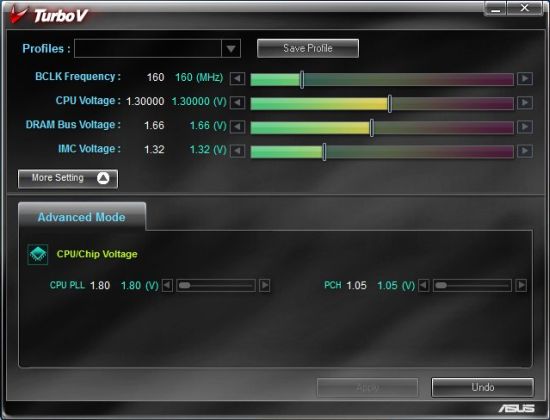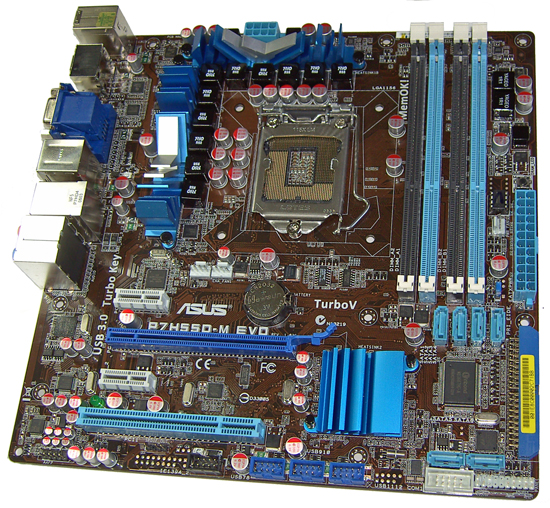Choosing the Best H55/H57 Motherboard - Part 1
by Rajinder Gill on January 31, 2010 11:30 PM EST- Posted in
- Motherboards
ASUS P7H55D-M EVO
The ASUS P7H55D-M EVO is currently priced at $135 at Newegg.
| ASUS H55D-M EVO | |
| Market Segment | H55 General Use/HTPC |
| CPU Interface | LGA-1156 |
| CPU Support | LGA-1156 i3/i5/i7 Series of Processors |
| Chipset | Intel H55 Express Chipset |
| BCLK Speeds | 80-500MHz in 1MHz increments |
| DDR3 Memory Speed | 800, 1067, 1333 Frequency Ratios |
| QPI Frequency | All supported mutlpier ratios available |
| Core Voltage | 0.85V ~ 1.70V in 0.00625V increments |
| CPU Vdroop Compensation | On/Off |
| CPU Clock Multiplier | Dependant on Processor, all available multipliers supported |
| DRAM Voltage DDR3 | Auto, 1.20V ~ 2.20V in 0.02V increments (1.50V base) |
| DRAM Timing Control | tCL, tRCD, tRP, tRAS, + 15 Additional Timings |
| DRAM Command Rate | Auto, 1N, 2N and 3N |
| PCH Voltage | Auto, 1.05V ~ 2V in .01V increments, 1.05V Base |
| CPU VTT (Uncore) Voltage | 1.1V ~ 1.90V in 0.02V increments |
| CPU PLL Voltage | 1.8V ~ 2.2V in 0.02V increments, 1.80V Base |
| Memory Slots | Four 240-pin DDR3 DIMM Slots Dual-Channel Configuration Regular Unbuffered DDR3 Memory to 8GB Total |
| Expansion Slots | 1X PCIe 2.0 16X Slot 2x PCIe X1 slots 1 X PCI slot |
| Onboard SATA/RAID | 6x SATA 3.0Gbps Ports - Intel Chipset Marvell 88SE6111 SATA and PATA Controller 1X Ultra DMA 133/100/66 for up to 2 PATA devices 1 X External SATA 3.0 Gb/s port |
| Onboard USB 2.0 | 10 USB 2.0 ports (4) I/O Panel, 6 via brackets 2 X USB 3.0 connectors on rear I/O (NEC USB 3.0 controller) |
| Onboard LAN | Realtek 8112L Gigabit LAN (PCI/e) |
| Onboard Audio | Realtek ALC889 High Definition Audio Codec, 7.1 Channel. |
| Other Onboard Connectors | 1X FPA, 1X 1394, 1X COM, 1X S/PDIF |
| Power Connectors | ATX 24-pin, 8-pin EPS 12V |
| I/O Panel | 1 x PS/2 Keyboard 1 x RJ45 4 x USB 2.0/1.1 1 x eSATA 2 x USB 3.0 1 x Optical Toslink 1 x HDMI 1 x RGB 6 Audio I/O jacks |
| Fan Headers | 1 CPU + 2 Additional Headers |
| Fan Control | Full temp/speed fan control for CPU header via BIOS or OS software Additional headers have 3 step speed control via BIOS or OS software |
| Package Contents | 2X SATA cables, 1 X UDMA cable, User Guide, 1 X Q-Connector, 1 X Driver/software DVD, 1 X I/O Shield. |
| Board/BIOS Revisions Used | Board Rev: 1.03G BIOS Files Used: 0503 and 0701 |
| Form Factor | uATX (9.6 in. X 9.6 in.) |
| Warranty | 3 Year Standard |
The P7H55D-M EVO package contents include: two SATA cables, one UDMA cable, User Guide, one Q-Connector, Driver/software DVD, and I/O Shield. That's a little light on SATA cables for our liking; a couple of extra would have been nice, as would the inclusion of a USB bracket to make use of the internal headers.
On the hardware front you get standard Realtek ALC889 audio, Realtek 8112L PCI-E LAN, two 1394 ports (VIA VT6308P), and two USB 3.0 ports thanks to the inclusion of NEC's controller chip. Unlike MSI and ASRock you don't get a TPM header; we're not sure what the uptake for this technology is right now, but it's something to bear in mind if you have plans to make use of it in the future.
Software
ASUS's driver DVD comes bundled with a slew of tools: PC Probe for software/temp monitoring, AI Suite/Fan Expert for setting up fan profiles, Express Gate for a quick-boot Linux environment, and Turbo-V for overclocking.

Turbo-V is a simple OS-based tool that allows on-the-fly changes to bus speeds and voltages, as well as offering the option to save profiles. A GPU level driver is also included, which allows for overclocking the IGP within the OS. We found the supplied version of Turbo-V to be fully functional with our 661 Clarkdale in testing. Out of the three vendors on test here today, ASUS seems to have come the closest to getting things working right first time.
The Board

Slot layout on the P7H55D-M EVO is good, although there's only one full length PCI-E x16 slot limiting upgrade options for add-in RAID cards if you go with a discrete GPU. Instead, ASUS offers two PCI-E x1 slots, with one placed to be accessible regardless of slot loading. The IDE port could have been left out, although you still get six accessible SATA ports at the lower right corner for the board in spite of its presence.
Three onboard fan headers are on offer. Fan control is not very comprehensive for the power and chassis fan headers; you get a three-step control, which can be applied to ramp dynamically via software profiles. You don't get any onboard power buttons either, barring Mem-OK, which acts as a solution to most non-boot situations related to overclocking.
Onboard cooling is more than adequate to take care of most overclocking. If you do overclock your Clarkdale CPU over 4GHz, some air cross-flow over the PWM heatsinks will keep them cool enough under normal usage. Heatsink height is low, so the board caters for a variety of CPU cooler installations without orientation issues - unless you install memory modules with very tall heat spreaders in the primary DIMM slots, which can make things a little tight for fan placement.
Overclocking

4GB memory overclocking is not class leading; use the 2:10 memory ratio and you'll find you're limited to around 175 BCLK (DDR3-1750). The alternative is to stick with 2:8 (DDR3-1600MHZ) at around 200 BCLK with a CAS of 6 or 7, modules permitting. The bonus to this configuration is you get to keep a reasonable QPI multiplier ratio, thus delivering reasonable performance.
Moving up to 8GB, you're looking at being capped at DDR3-1550~1580 unless you relax the QPI multiplier ratio, which does not really make sense from a performance standpoint. Real world differences are of course small either way, but we aim to take whatever we can get from the chipset.
BIOS
BIOS 0701 is the comprehensive functionality and overclocking release from ASUS. You get the full array of DRAM timing options included from tRD register manipulation to fine control of voltage rails. DRAM timing adjustments are easy to make because the BIOS shows you every setting value when you select AUTO mode for the timings, giving you a base to work from. You can change one setting at a time while leaving all others on AUTO and it's simple to change something back if things go wrong. MSI would do well to learn something from this approach.
Voltage adjustments can be made easily too; you can type the voltage value in directly and the board will select the nearest offset. The ranges are quite granular so there's plenty of room for fine-tuning.
There are eight BIOS save locations available for profiles, which come in handy during initial setup or overclocking adventures. A built-in BIOS flashing routine is also provided, allowing easy updates from a USB pen drive or from a HDD.





















56 Comments
View All Comments
Rajinder Gill - Monday, February 1, 2010 - link
Hi AG,I think Anand touched on some AMD/Intel compares in his Clarkdale articles. Have a look at these and see if they offer some of what you are looking for;
http://www.anandtech.com/cpuchipsets/showdoc.aspx?...">http://www.anandtech.com/cpuchipsets/showdoc.aspx?...
http://www.anandtech.com/cpuchipsets/showdoc.aspx?...">http://www.anandtech.com/cpuchipsets/showdoc.aspx?...
regards
Raja
Rajinder Gill - Tuesday, February 2, 2010 - link
Forgot to mention, check out the Anandtech bench beta for CPU performance compares:http://www.anandtech.com/bench/default.aspx?b=2">http://www.anandtech.com/bench/default.aspx?b=2
regards
Raja
JonnyDough - Thursday, February 11, 2010 - link
Will there be a graphics chart beta soon too? Please say yes. :)Rajinder Gill - Thursday, February 11, 2010 - link
Hi JD,Can't give you a time frame on it yet unfortunately, but yes, we will be adding GPU's at some point..
regards
Raja
JonnyDough - Friday, February 12, 2010 - link
That's fantastic news, there are other sites I just don't trust to do it right. :)I'm sure you'll be deliberating what test beds to use, and so on. We really need to see both dual and quad core, with at least a couple of older processors (939 athlons?) thrown in for reference. Or let us know the best card that those platforms can realistically support as many of us still use these PCs for gaming.
Many basic users fail to understand resolution and their game settings. It can be tough to know just what your card is designed to do within any certain application. For instance, some cards run higher frame rates than others with AA turned off, but then with it turned on they the cards will switch. What would be nice is to see a chart that shows checkmarks and X's for "above X-fps" for games. Allow me to better describe what I mean:
I don't honestly care if a card does 60 vs 65 fps in Fallout 3, just whether or not it can play Fallout 3 with max settings, and also play Bioshock 2 at max settings.
Rather than tell me what FPS a card gets, just simplify by showing ranges. If my card can't get "above 30fps" put an X for that game on the table. If a game isn't playable below 45FPS, then you won't need to list it for any cards unable to do that many. Above 40fps for the next box, and so on.
This sort of testing might not only make it easier to create your tables, but be more useful to shoppers. I don't need to know if a 5770 can do 120FPS in WoW because quite honestly, it doesn't matter if it can only do 60. I just want to know, can it play it with the eye candy on, or not?
deputc26 - Monday, February 1, 2010 - link
You run a tight ship Anand! :)